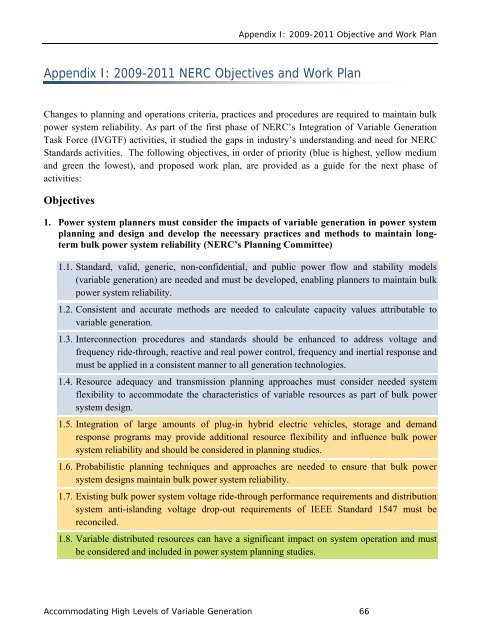Accommodating High Levels of Variable Generation - NERC
Accommodating High Levels of Variable Generation - NERC
Accommodating High Levels of Variable Generation - NERC
You also want an ePaper? Increase the reach of your titles
YUMPU automatically turns print PDFs into web optimized ePapers that Google loves.
Appendix I: 2009-2011 Objective and Work Plan<br />
Appendix I: 2009-2011 <strong>NERC</strong> Objectives and Work Plan<br />
Changes to planning and operations criteria, practices and procedures are required to maintain bulk<br />
power system reliability. As part <strong>of</strong> the first phase <strong>of</strong> <strong>NERC</strong>’s Integration <strong>of</strong> <strong>Variable</strong> <strong>Generation</strong><br />
Task Force (IVGTF) activities, it studied the gaps in industry’s understanding and need for <strong>NERC</strong><br />
Standards activities. The following objectives, in order <strong>of</strong> priority (blue is highest, yellow medium<br />
and green the lowest), and proposed work plan, are provided as a guide for the next phase <strong>of</strong><br />
activities:<br />
Objectives<br />
1. Power system planners must consider the impacts <strong>of</strong> variable generation in power system<br />
planning and design and develop the necessary practices and methods to maintain longterm<br />
bulk power system reliability (<strong>NERC</strong>’s Planning Committee)<br />
1.1. Standard, valid, generic, non-confidential, and public power flow and stability models<br />
(variable generation) are needed and must be developed, enabling planners to maintain bulk<br />
power system reliability.<br />
1.2. Consistent and accurate methods are needed to calculate capacity values attributable to<br />
variable generation.<br />
1.3. Interconnection procedures and standards should be enhanced to address voltage and<br />
frequency ride-through, reactive and real power control, frequency and inertial response and<br />
must be applied in a consistent manner to all generation technologies.<br />
1.4. Resource adequacy and transmission planning approaches must consider needed system<br />
flexibility to accommodate the characteristics <strong>of</strong> variable resources as part <strong>of</strong> bulk power<br />
system design.<br />
1.5. Integration <strong>of</strong> large amounts <strong>of</strong> plug-in hybrid electric vehicles, storage and demand<br />
response programs may provide additional resource flexibility and influence bulk power<br />
system reliability and should be considered in planning studies.<br />
1.6. Probabilistic planning techniques and approaches are needed to ensure that bulk power<br />
system designs maintain bulk power system reliability.<br />
1.7. Existing bulk power system voltage ride-through performance requirements and distribution<br />
system anti-islanding voltage drop-out requirements <strong>of</strong> IEEE Standard 1547 must be<br />
reconciled.<br />
1.8. <strong>Variable</strong> distributed resources can have a significant impact on system operation and must<br />
be considered and included in power system planning studies.<br />
<strong>Accommodating</strong> <strong>High</strong> <strong>Levels</strong> <strong>of</strong> <strong>Variable</strong> <strong>Generation</strong> 66
















